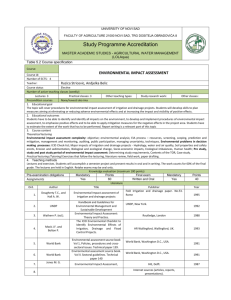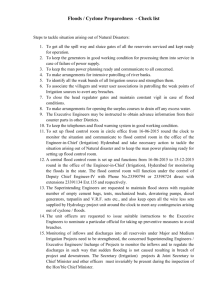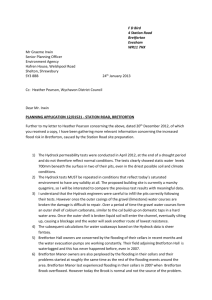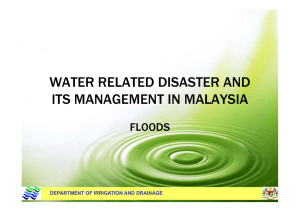INTEGRATED SAFEGUARDS DATA SHEET
advertisement
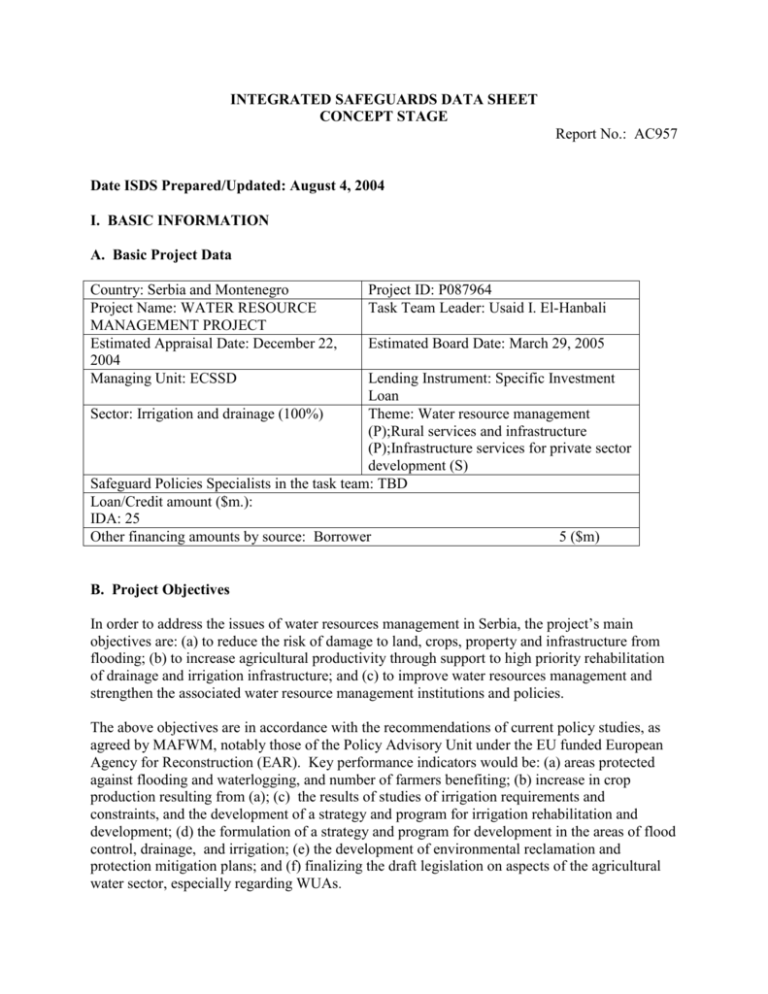
INTEGRATED SAFEGUARDS DATA SHEET CONCEPT STAGE Report No.: AC957 Date ISDS Prepared/Updated: August 4, 2004 I. BASIC INFORMATION A. Basic Project Data Country: Serbia and Montenegro Project Name: WATER RESOURCE MANAGEMENT PROJECT Estimated Appraisal Date: December 22, 2004 Managing Unit: ECSSD Project ID: P087964 Task Team Leader: Usaid I. El-Hanbali Estimated Board Date: March 29, 2005 Lending Instrument: Specific Investment Loan Sector: Irrigation and drainage (100%) Theme: Water resource management (P);Rural services and infrastructure (P);Infrastructure services for private sector development (S) Safeguard Policies Specialists in the task team: TBD Loan/Credit amount ($m.): IDA: 25 Other financing amounts by source: Borrower 5 ($m) B. Project Objectives In order to address the issues of water resources management in Serbia, the project’s main objectives are: (a) to reduce the risk of damage to land, crops, property and infrastructure from flooding; (b) to increase agricultural productivity through support to high priority rehabilitation of drainage and irrigation infrastructure; and (c) to improve water resources management and strengthen the associated water resource management institutions and policies. The above objectives are in accordance with the recommendations of current policy studies, as agreed by MAFWM, notably those of the Policy Advisory Unit under the EU funded European Agency for Reconstruction (EAR). Key performance indicators would be: (a) areas protected against flooding and waterlogging, and number of farmers benefiting; (b) increase in crop production resulting from (a); (c) the results of studies of irrigation requirements and constraints, and the development of a strategy and program for irrigation rehabilitation and development; (d) the formulation of a strategy and program for development in the areas of flood control, drainage, and irrigation; (e) the development of environmental reclamation and protection mitigation plans; and (f) finalizing the draft legislation on aspects of the agricultural water sector, especially regarding WUAs. C. Project Description The project size is about US$ 30 million consisting of a $25 million credit and a $5 million borrower contribution. The project has a five year implementation period. The land benefiting from improved drainage is about 350,000 ha, with 200,000 inhabitants benefiting from improved flood protection. The returns to the economy, from increased agricultural productivity, increased incomes and associated fiscal benefits, and reduced losses from flooding, would be substantial. The main components would include: Component 1. Rehabilitation and Improvement of Water Resources Infrastructure. The rehabilitation and improvement works would include: (a) restitution of the flood control defenses and the upgrading of the flood forecasting facilities; (b) restitution of the drainage facilities; and (c) a construction of pilot minor irrigation systems. Component 2. Technical Assistance This component would include: (a) a study for requirements and constraints for future irrigation sub-sector development, and the initiation of measures to remove these constraints, including a feasibility study of priority areas and for a pilot minor irrigation system; (b) institutional reform, capacity building, and improved water sector management; (c) upgrading of the flood forecasting and warning system; and (d) training. Component 3. Equipment and Vehicles This would include provision of equipment for flood forecasting and warning system, O&M and office equipment and vehicles. D. Project location Although the project has a country-wide coverage, all of the drainage and flood control works (about 80% of the planned investments) will be concentrated in the northern Vojvodina region, and the remaining for pilot irrigation management will be concentrated in the southern region. E. Borrower’s Institutional Capacity for Safeguard Policies The implementing agency, the Ministry of Agriculture, Forestry and Water Management and its subordinate Departments and Directorates are supported by long established technical institutes and the universities. These agencies at present suffer from diminished professional staff due to migration, and equipment and facilities also require modernization and rehabilitation. Also, there is a need to reorganize the sector and introduce a more participatory and integrated approach to water management. In spite of these shortcomings, there is still a viable professional specialist cadre in Serbia to sustain the reorganisation and reinstatement of agriculture given stability and funding provision. However, these institutions need to be familiarized and trained on the Bank ‘s Safeguard Policies. II. SAFEGUARD POLICIES THAT MIGHT APPLY Applicable? [YES ] [ TBD] [NO ] [ NO] [NO] Involuntary Resettlement (OP/BP 4.12) There is such a low probability for the irrigation activities to trigger this OP, that it is unlikely the project will present land acquisition or resettlement issues. There are plentiful choices for pilot areas; they will be selected to avoid land acquisition. Indigenous Peoples (OD 4.20) [NO ] Forests (OP/BP 4.36) [ YES] Safety of Dams (OP/BP 4.37) During project preparation, dam safety analyses will be focused specifically in catchment areas where investments are planned (e.g. 80% of the financing in the northern part of the country, and part of the remaining funding in any smaller pilot areas in the South.) At this time we do not expect to finance flood protection and drainage sub-projects in such a widespread nature as to require analysis of all dams in the country; only in focused areas. Cultural Property (draft OP 4.11 - OPN 11.03) Cultural property OP will be covered as part of the EA. The project is not expected to finance construction activities in cultural or historical sites. Procedures to deal with chance finds will be spelled out in the EMP. [NO] [ NO] * Safeguard Policy If Applicable, How Might It Apply? Environmental Assessment (OP/BP 4.01) During project preparation environmental and social assessments will be prepared and submitted to the Bank. The EA will look at all environmental issues related to this project specially the soil and water pollution in areas of intervention. A link will be established with a proposed GEF-funded Danube River Enterprise Pollution Protection Project. It is expected that the Environmental Management Plan (EMP) will include two parts: a specific one focusing on the northern region where most of the investment for flood and drainage rehabilitation works will be located; and a generic one for pilot irrigation sub-projects, which will be located in the southern part of the country and will be selected on the basis of the demand of farmers. Natural Habitats (OP/BP 4.04) Natural habitats will be covered as part of the EA – EMP (specific part) Pest Management (OP 4.09) Projects in Disputed Areas (OP/BP/GP 7.60)* By supporting the proposed project, the Bank does not intend to prejudice the final determination of the parties' claims on the disputed areas [ YES] Projects on International Waterways (OP/BP/GP 7.50) The project is on international waterways. However, since the investments expected under the project are mostly rehabilitation and improvement of existing flood control and drainage schemes, they will not change the volume of extraction/discharge of water or quality of water. The team will consult with Legal to see whether a waiver to notification is appropriate. Environmental Assessment Category: [ ] A [X] B [ ] C [ ] FI [ ] TBD (to be determined) If TBD, explain determinants of classification and give steps that will be taken to determine that EA category (mandatory): III. SAFEGUARD PREPARATION PLAN A. Target date for the Quality Enhancement Review (QER), at which time the PAD-stage ISDS would be prepared. November 2004. IV. APPROVALS Signed and submitted by: Task Team Leader: Approved by: Regional Safeguards Coordinator: Comments Sector Manager: Comments Usaid I. El-Hanbali 08/03/2004 Ronald Hoffer 07/27/ 2004 Joseph Goldbeg 08/03/2004
